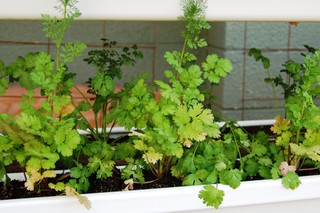How to grow cilantro indoors

Many have witnessed the often polarizing effects of the seemingly innocent herb, cilantro. Revered by some as the holy grail of garnishes, a portion of the population disagrees, relating it to the punishment of washing one’s mouth out with soap.
But for those of you on Team Cilantro and looking to grow it indoors as a houseplant, you’re in luck!
Cilantro (Coriandrum sativum) is an excellent herb for growing indoors—as either full-sized plants or microgreens. Plants need at least six hours of full sun per day or supplemental lighting. They prefer temperatures between 50 and 80°F and moist potting soil. Direct seeding is recommended for growing full-sized plants or microgreens; propagation using stem cuttings can be used to grow full-sized plants. Choose plastic or glazed ceramic containers and a growing media that is well-draining.

Supplies for growing cilantro indoors
It’s easy to start growing cilantro indoors, and all you need is a few basic supplies. The supplies required are similar whether you are growing full-sized plants or microgreens, with a couple of exceptions.
Containers
Choose either glazed clay or plastic pots for growing cilantro plants because they keep the soil moister than terra cotta. Make sure the container has drainage holes.
- Full-sized plants do best in deep containers because of their long taproot. If growing a single plant, an 8-inch pot is sufficient; 3 plants can be grown together in a 12-inch container.
- Choose shallow, wide containers or trays for growing microgreens. A 10” x 20” tray is a good size – we recommend this one that you can find on Amazon.
For more on choosing the right pot, check out our complete pot selection guide.
Growing media
Commercial potting mixes and coconut coir both make excellent substrates for growing either plants or microgreens. They are lightweight and have excellent water retention while allowing excess moisture to drain out the growing media quickly.
- Potting soils contain no soil but are a mix of peat moss or coconut coir, pine bark, perlite, and vermiculite. Our top pick for potting soil is FoxFarm, and you can find it here on Amazon.
- Coconut coir is a renewable material made from the brown and white fibers found between the shell and the outer coating of a coconut seed.
To learn more about the best substrate for container-grown herbs, read our post on growing media.
Seeds or plants

There are different options when it comes to planting cilantro for your herb garden—you can start plants from seed, you can propagate from mature plants, or you can purchase young plants to grow.
- Cilantro seeds are inexpensive and can be used when growing microgreens or full sized-plants.
- Cuttings cost nothing if you have access to a healthy, mature plant but only result in full-sized plants.
- Young plants are the easiest but the most expensive option and cannot grow microgreen, only full-sized plants.

The enthusiast's guide to herbs
We’re proud to present our new e-book, The Enthusiast’s Guide to Herbs! Learn everything you need to know about growing and caring for herbs indoors, including in-depth info cards for the 35 most commonly grown herbs.
Click the link below to find out more!
Planting Instructions
The instructions for planting cilantro vary slightly depending on the method and the desired result, i.e., whether you are growing mature plants or just want microgreens.
Starting cilantro from seed:
- Fill the container(s) with the pre-moistened growing media of your choice.
- Plant cilantro seeds ¼” deep and cover lightly with potting soil.
- Place container(s) in an area where the ambient temperature is at least 70°F.
- Keep the soil moist but not saturated. Too much water pushed air out of the growing media in the root zone, causing oxygen deficiencies.
- Thin plants when cilantro seedlings are about two inches tall. Keep the single, best-looking plant for an 8-inch container. A 12-inch container is large enough to grow three seedlings if they are well spaced.
Starting cilantro from stem cuttings:
- Take a 4-inch stem cutting right below a node and remove all of the leaves from the bottom 2 inches of the stem.
- Place the cut end of the stem in a glass or jar of water, allowing it to grow until newly generated roots are a couple of inches long.
- Fill the container(s) with pre-moistened growing media of your choice.
- Carefully plant newly rooted cuttings in the substrate, one cutting per 8-inch pot and 3 per 12-inch container.
Starting microgreens
- Fill the container with potting soil and sow seeds over the entire surface of growing media in the tray. When using a standard seed tray, the best yield is seen when you seed 26 ounces per tray. [1]
- Do not cover the seeds with soil, and stack a tray on top to compress the seeds. Use a weight like a hardcover book inside the top tray to provide compression.
- Place container(s) in an area to sprout where the ambient temperature is at least 70°F.
- After 24 hours, use a mister, spray bottle, or fine droplet watering hose, and lightly saturate the soil with water. You do not want to flood the tray, or the seeds will displace. Water once a day, and remember to check the soil surface’s moisture level; always underwater instead of overwater.
Caring for your cilantro plant

Light
Indoor plants need a high amount of sunlight to see maximum growth and yield. Cilantro needs at least 6 to 8 hours of direct sunlight when grown outdoors, so strive for at least this amount inside. South or westwardly-facing window sills provide the most sunlight and are best for growing herbs that need a lot of light.
Oftentimes indoor gardening spaces cannot provide the full-sun conditions similar to growing outside; in this case, plants should be supplemented with light via grow lights. A simple 45 watt LED lamp can be suspended just above the plant’s surface to provide extra light. This prevents the cilantro from becoming “leggy” as it strains to find sunlight. As the plant grows, the light should be raised.
Temperature
Cilantro is classified as a cool-season plant, so it grows best when temperatures are between 50 and 80°F. Seeds need at least 55-68 degrees Fahrenheit to germinate. Plants can survive a light frost when grown outdoors, but ensure plants are protected from chilly drafts when growing containers inside.
One of the benefits of growing cilantro indoors is the controlled environment. When outside temps rise above 85°F, the cilantro plant is triggered to go into reproductive mode. Known as bolting, the leaves become thin, the flavor is lost, and large umbrella-like structures form flowers and seed pods.
For more information on bolting and how to prevent it, read our article here.
Water
Cilantro growing in containers likes its potting soil to stay moist without being waterlogged. Proper drainage is the key to healthy cilantro.
Water full-sized plants thoroughly—until water runs out the bottom of the container—when the soil surface starts to dry out. Keep soil for microgreens consistently damp without being too wet. Too much soil moisture encourages problems with damping-off, powdery mildew, and aphids, especially with high seed density.
Remember: plants crave moisture, not water, and underwatering is always better than overwatering.
A spray bottle is the ideal method of irrigation when germinating seeds and watering seedlings. A cheap alternative can be a plastic water bottle with small holes punched into the tightened lid. If the soil is so dry that it has difficulty absorbing, be patient; allow the water to saturate the soil before dosing with water again.
Rainwater or distilled water is best, but tap water is acceptable if you don’t have a water softener. If your water is chlorinated, fill a container with water and let it sit for 24 hours to allow the chlorine to evaporate before using.
Air Circulation
Some air circulation is good for cilantro, especially when growing microgreens. Cilantro is susceptible to damping off, a fungus that first appears as white mold and shrivels the stems until the seedlings die.[2] Prevent this by generating a little air movement through the plants using a small fan.
Fertilizer
Because the cilantro plant will have a finite supply of space in the container and therefore limited nutrients, it is vital to keep your container fertilized. A diluted fish emulsion (like this one you can find here on Amazon) is an excellent option for adding nutrients into the soil, but use the amount recommended for the size of your container. Over fertilizing is just as detrimental!
If you are interested in learning more about fertilizing, check out our post on properly fertilizing herbs.
Harvesting

Harvesting cilantro happens on a different timeline for microgreens versus full-sized plants. Regardless of the growing method, always use clean scissors and clean hands when harvesting. Microgreens are ready to harvest after about 20 days, full-sized plants are ready when they reach about 6 inches.
Cilantro is an annual herb with a short life cycle. Unfortunately, it’s not a “cut-and-come-again” type of herb and is typically enjoyed for 8-10 weeks. A general rule of thumb is to snip ⅓ of the plant per week.
If you want an endless supply, direct sow your seeds every 2-3 weeks and pinch off the cilantro tops to extend the plant’s lifespan.
History and application of cilantro
Cultures across the globe have embraced cilantro – also known as Chinese parsley – as their own for centuries. The earliest recorded coriander was found in Israel and dates back to 6,000 B.C.E.[3] Pinpointing the origin is difficult, but spanning across cultural cuisines, the herb is almost always used raw. Once dried, the seed heads are used to produce the popular spice coriander.[4]
In most cuisine, fresh cilantro is used to maintain the complex, acidic, pungent flavor. All varieties will do well in an indoor environment. You’ll find cilantro leaves in Mexican, Indian, Middle Eastern, Asian, South American, and North American cuisine. It is prevalent in salsas and soups.
Medicinal properties of cilantro
Because the use of cilantro and coriander is ancient and widespread, there are many claims to its health benefits and healing properties. Scientific research supports the antioxidant nature of cilantro; leaf extracts can suppress oxidation stress and reduce radical scavengers. [5]
FAQ
Does cilantro grow well in pots?
Yes, cilantro does grow well in pots when adequately cared for. One of the critical steps is choosing pots with drainage holes to allow excess water to drain. Use coconut coir or potting soil to fill containers and keep it moist without it being saturated. Make sure your plant gets at least 6 to 8 hours of sunlight, and the temperature is between 50 and 80 degrees Fahrenheit.
Can you grow cilantro inside year-round?
Yes, you can grow cilantro inside year-round, making it so you have a supply of fresh herbs whenever you need it. However, to do so, you will need to plant new seeds continuously, as cilantro is a short-lived annual plant. In the winter, when days are shorter, it may be necessary to supplement lighting with an LED grow lamp.
Does cilantro grow back after harvesting?
No, unlike some other species of herbs, cilantro does not grow back once you harvest material from the plant. It is not considered a “cut-and-come-again” herb, so once you begin harvesting you can expect to harvest leaves for about 8 to 10 weeks before the plant reaches the end of its life.

Join our email club—get printable info cards free!
Sign up to receive our newsletter and get access to 10 printable plant info cards from our e-book for free. Also receive:
- $4 discount code for our Guide to Herbs e-book
- Semi-weekly plant inspiration & bite-size tips and tricks
Johnny’s Selected Seeds. n.d. “Johnny’s Micro Greens Yield Trial: Comparison Chart for 29 Popular Varieties.” Accessed September 27, 2021. ↩︎
Smart Gardener. n.d. “Damping Off.” Accessed September 27, 2021. ↩︎
Levy, Faye. 2006. “Cilantro - the biblical herb.” The Jerusalem Post, February 2, 2006. ↩︎
UF/IFAS Gardening Solutions. n.d. “Cilantro.” Accessed September 27, 2021. ↩︎
Singletary, Keith. 2016. “Coriander: Overview of Potential Health Benefits.” Nutrition Today, 51 (3): 151-161. ↩︎
